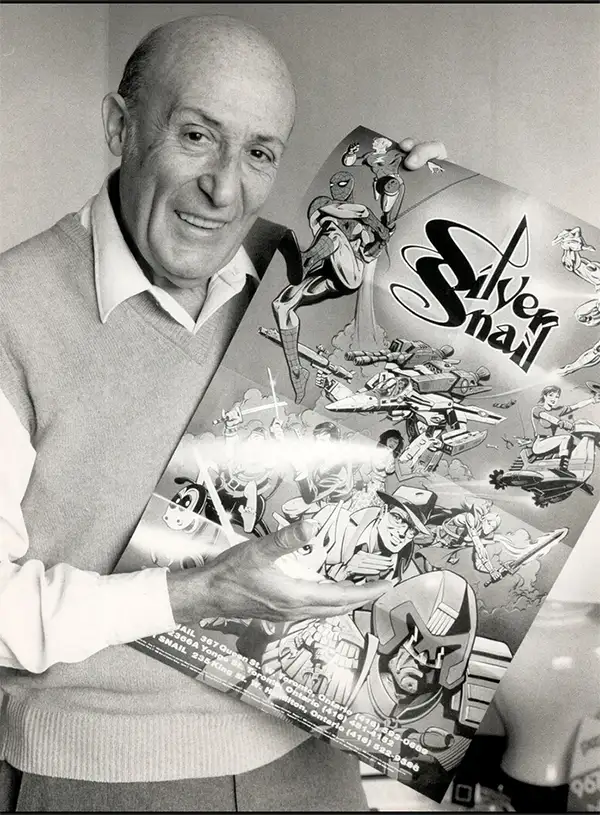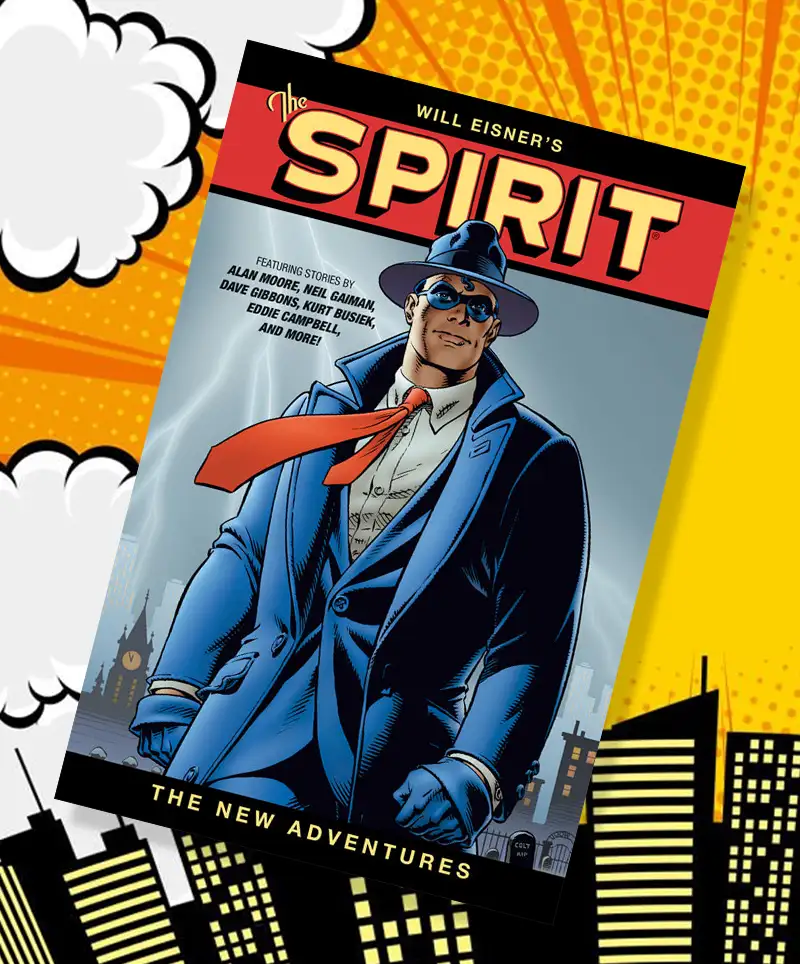The Man Who Drew the Future
Will Eisner Week is a time to celebrate one of the most influential figures in comics history—a man whose name is synonymous with the very concept of the graphic novel. If you’ve ever enjoyed a comic book with a cinematic layout, a superhero who has emotions or a story that transcends the usual capes-and-crime formula, you owe a debt to Will Eisner. He wasn’t just an artist but an innovator, teacher, and storyteller whose influence stretched far beyond the pages he filled.
From Pencils to Print
Born in 1917, Will Eisner grew up in New York City, surrounded by the hustle and bustle of immigrant life. He had a natural talent for art, which—lucky for the world—was noticed early. Unlike most kids, who dreamt of being firemen, astronauts, or baseball players, Eisner wanted to tell stories with pictures. And boy, did he.
In high school, Eisner's artistic talent earned him recognition, and he soon found himself sketching cartoons and illustrations for school publications. Encouraged by teachers and peers, he decided to pursue art as a career. It wasn't an easy road—comics in the 1930s were often dismissed as lowbrow entertainment, but Eisner saw their potential as a serious storytelling medium.
 In the 1930s, comics were still figuring out what they wanted to be. Eisner, however, was already pushing the boundaries. Teaming up with Jerry Iger, he formed one of the first comics studios, producing stories for publishers desperate to fill their pages. It was here that Eisner honed his craft, proving that comics could be more than just cheap entertainment—they could be art.
In the 1930s, comics were still figuring out what they wanted to be. Eisner, however, was already pushing the boundaries. Teaming up with Jerry Iger, he formed one of the first comics studios, producing stories for publishers desperate to fill their pages. It was here that Eisner honed his craft, proving that comics could be more than just cheap entertainment—they could be art.
During this period, Eisner's studio produced a range of content, from adventure and detective tales to humor strips. He quickly gained a reputation for his sharp storytelling skills and dynamic compositions. Unlike many of his peers, who treated comics as a stepping stone to other artistic fields, Eisner embraced the medium wholeheartedly. His commitment would eventually lead to revolutionary changes in how comics were perceived and created.
A Hero Without a Cape
Superheroes were all the rage in the 1940s, but Will Eisner had a different idea. Instead of creating yet another flying, bulletproof do-gooder, he gave us The Spirit, a detective with no superpowers, just a sharp wit and a fedora. The Spirit was groundbreaking, not just because of its character but because of how Eisner told the stories. His layouts broke free from the rigid panel grids, his angles were cinematic, and his use of shadows could rival any noir film.
When The Spirit debuted in 1940, it was unlike anything else on the comics scene. While most superhero stories of the time were simplistic, good-versus-evil affairs, The Spirit tackled more complex narratives, often exploring themes of crime, corruption, and human nature. Eisner’s innovative storytelling style incorporated splash pages that functioned as visual prologues, drawing readers into the action before they even reached the dialogue.
Eisner also infused The Spirit with humor, social commentary, and even tragedy—elements rarely found in comics at the time. The stories were a mix of pulp fiction, crime drama, and occasional absurdity, making it a weekly must-read.
Another defining feature of The Spirit was its supporting cast. Eisner gave considerable attention to secondary characters, ensuring that they weren’t mere plot devices but fully fleshed-out individuals with their own motivations and arcs. From the villainous femme fatale Sand Saref to the lovable sidekick Ebony White, these characters contributed to the rich tapestry of the comic’s world.
If anyone doubted that comics could be sophisticated, Eisner’s work quickly erased those doubts (though some publishers still needed a little convincing—perhaps with a well-placed blackjack).
The Graphic Novel Pioneer
After a brief detour into military comics during World War II (yes, even war manuals needed some visual flair), Eisner took on an even bigger challenge: proving that comics could be serious literature. In 1978, he released A Contract with God, a collection of interwoven stories about life in a Jewish tenement. It wasn’t about superheroes, spies, or monsters—it was about real people, their struggles, and the raw emotions that made them human.
At the time, the phrase “graphic novel” wasn’t even common. Eisner didn’t just create a book—he legitimized an entire format. While comics had long told serialized adventure stories, they had rarely been treated as serious works of art or literature. Eisner’s approach changed that, proving that sequential art could be as profound and moving as any novel.
A Contract with God wasn’t just revolutionary in content but also in execution. Eisner’s mastery of composition and panel design allowed him to convey deep emotions and complex themes in ways that words alone could not. The book tackled themes of faith, loss, ambition, and the immigrant experience, drawing from Eisner’s own background and observations of New York life.
The success of A Contract with God paved the way for future graphic novels. Eisner continued exploring the form with works like Dropsie Avenue, To the Heart of the Storm, and Fagin the Jew, each pushing the boundaries of what comics could achieve. Today, when you walk into a bookstore and see shelves of beautifully drawn, deeply emotional stories, you have Will Eisner to thank. (Though your wallet might not be as grateful.)
The Teacher and the Legacy
Eisner wasn’t content with just creating comics—he wanted to elevate the medium. He spent years teaching, writing textbooks, and giving lectures on the craft of visual storytelling. His book Comics and Sequential Art is still considered a bible for aspiring artists, proving that comics require as much thought and technique as any other form of literature.
His influence is everywhere. If you’ve ever been moved by a graphic novel, stunned by an inventive comic panel, or marveled at how a story unfolds visually, you’re experiencing a piece of Eisner’s legacy. He set the standard, broke the mold, and left a lasting impact on generations of creators.
Why We Celebrate Will Eisner Week
Will Eisner Week isn’t just about remembering a great artist—it’s about recognizing the power of comics as a medium. It’s a time to celebrate creativity, innovation, and storytelling in all its forms. Eisner showed the world that comics weren’t just for kids; they were for anyone who wanted to experience a story in a way that only sequential art could deliver.
So, whether you’re revisiting The Spirit, diving into A Contract with God, or sketching your own graphic novel, take a moment to appreciate the man who made it all possible. Will Eisner didn’t just draw comics—he changed them forever. And for that, the world of storytelling will always be in his debt.
Please Share our Content






 In the 1930s, comics were still figuring out what they wanted to be. Eisner, however, was already pushing the boundaries. Teaming up with Jerry Iger, he formed one of the first comics studios, producing stories for publishers desperate to fill their pages. It was here that Eisner honed his craft, proving that comics could be more than just cheap entertainment—they could be art.
In the 1930s, comics were still figuring out what they wanted to be. Eisner, however, was already pushing the boundaries. Teaming up with Jerry Iger, he formed one of the first comics studios, producing stories for publishers desperate to fill their pages. It was here that Eisner honed his craft, proving that comics could be more than just cheap entertainment—they could be art.








 "Sláinte!" is a traditional Irish expression used as a toast, equivalent to "Cheers!" in English.
"Sláinte!" is a traditional Irish expression used as a toast, equivalent to "Cheers!" in English.